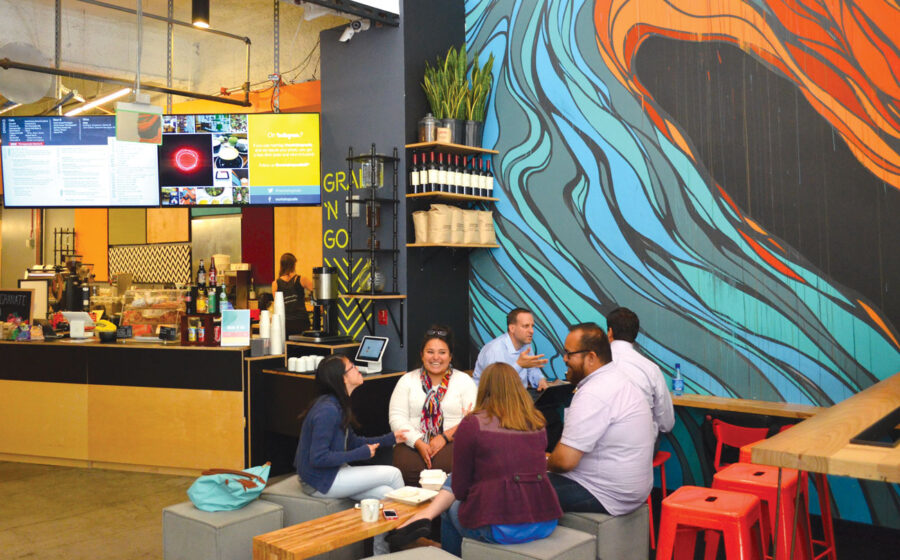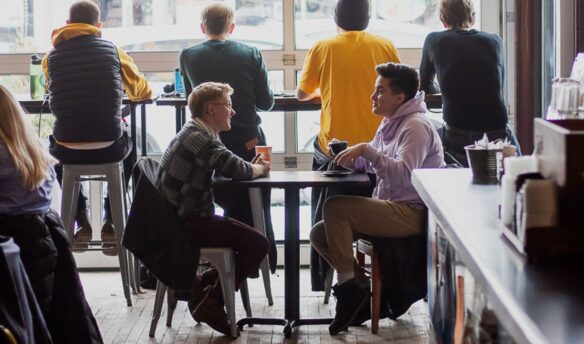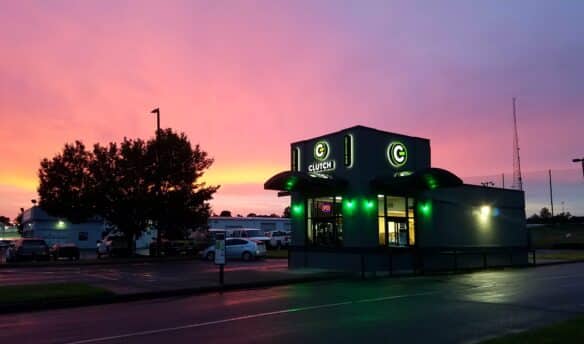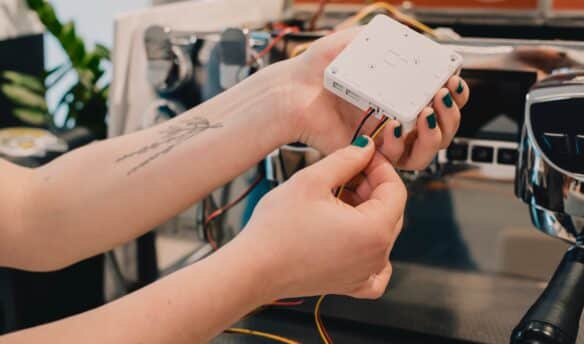Cafés, especially those with free Internet, are often a mecca for self-employed and telecommuting workers. Most weekdays you’re likely to see several laptop-toting writers, web designers, and consultants parked near the power outlets at your neighborhood coffeeshop, interspersed with students, stroller-wielding parents, and professionals seeking a change of scenery from their offices.
But as the ranks of independent and telecommuting workers have grown—the Bureau of Labor Statistics reported that more than 9.7 million Americans were unincorporated, self-employed workers as of June 2015—that work arrangement isn’t always ideal for the coffeehouse or its patrons, especially in smaller shops with limited seating. In fact, some shops have instituted time limits during peak hours to discourage workers from buying a single latte and lingering for hours, taking up valuable table space.
Coworking Space vs Café, or Both Together?
Some patrons have migrated to one of the thousands of coworking spaces popping up across the country over the past few years. Many of these communal work spaces position themselves as an alternative to working out of coffeeshops, with fast, reliable Wi-Fi, guaranteed access to a desk with an outlet and a community of like-minded professionals, plus no sound effects like screaming children or humming espresso machines.
Increasingly, though, the lines are blurring between cafés and coworking spaces as businesses open under a hybrid model combining the coziness, convenience, and quality coffee of a café with the productivity and equipment of a coworking space.
The hybrid model has pluses and minuses for operators, says David James, cofounder of CoworkCafé, which opened earlier this year in Arlington, Virginia, and rents space from Boccato Gelato and Espresso. His space operates on a monthly membership model that includes a fifty-dollar food and beverage credit (Boccato serves Stumptown Coffee Roasters). The bulk of revenue comes from memberships, as many members don’t even use the full food and beverage credit, much less order additional food or beverages.
James says the biggest difference between a coworking space and a coffeeshop is the mindset of the customers. The same person who frequents a coffeeshop and a coworking space will have different expectations of each setting and expect a coworking space to be conducive to working, even if they can also order coffee there. “If you don’t control the space really well, don’t have the right music, haven’t thought through the seating layout, if there’s somebody talking to you loudly on the phone—these intangible things can destroy the work environment,” he says.
CoworkCafé members can also choose different workstations including high and low tables, couches, and love seats depending on their mood. They can also use one of four private phone booths for calls. “It’s more difficult in that when people are paying for the space, they have higher expectations in terms of reliability,” James says.
“They want to make sure that they have a space available. One of the benefits of having this membership is that you can control space a lot better.” Customers also expect faster and more reliable Internet when they’re paying a monthly membership fee rather than buying a latte at a coffee shop, he adds. Most coffee shops don’t offer technical support and back-up Internet, but coworking space members may expect it.
Setting Up Your Coworking Café Space and Membership
Remote workers also demand lots of power outlets for charging laptops and phones. “We added about fifty plugs in addition to what was already there,” James says. “A lot of coffee shops are doing the opposite of that by taking away plugs to discourage people from camping out.”
A membership model is easier to operate in some ways, because catering to repeat customers is often simpler than a constant churn of brand new customers. “They know what to do, and we don’t need to have the same level of staff,” James says. “They’re not super anxious to get their drink, because they’re gonna be sitting there for awhile. We can make those drinks when there’s time.”
A hundred and fifty miles north of Arlington is Work in Harmony Café, a 1,500-square-foot space in Collingswood, New Jersey. Its front café is open to the public and serves Specialty Java organic coffee, tea, lattes, iced beverages, and baked goods. The café has a sitting limit of two hours.
Those seeking a quieter work area or more time to work can rent one of nine semi-private cubicles, the lounge, or the conference room on an hourly, daily, or weekly basis. Work in Harmony also offers monthly memberships, complete with printer and Wi-Fi access and a ten-drink punch card. Rental fees and memberships account for a larger portion of Work in Harmony’s revenue than coffee because of their higher price tag. “If somebody rents the conference room for one day it’s two hundred dollars, which would be a hundred small cups of coffee,” says Michelle Polidoro, who opened the space with her daughter last June.
In addition to locals, Polidoro says the space attracts professionals visiting the area. “They can come in and have a quiet space to work and know that the Internet is secure,” she adds. The availability of coffee and food at Work in Harmony means workers can stay longer than they might at a regular coworking space because “you don’t need to go up the street to get a cup of coffee.”
Taking phone calls can be challenging in a crowded coffee shop or coworking space, so if the conference room is empty Polidoro lets customers use it gratis for their calls. “Instead of them being around others, they can go in there and have a private call,” she says.
And while many coworking spaces are large, industrial-type warehouse spaces, Polidoro says Work in Harmony offers a homier setting (in fact, she posted an inspirational saying in each of the cubicles and the lounge offers an electric fireplace). “Our space is very comfortable and very peaceful,” she says. “People like having that kind of environment to get their work done.”
The Hourly Coworking Model
Unlike CoWorkCafé and Work in Harmony Café, San Francisco’s Workshop Café, which opened in September 2013, does not offer monthly memberships. Instead, customers can pay around two dollars an hour for workspace, while the patio and front lounge is free for customers who order food or beverages (both groups get free Wi-Fi access). “A lot of people want the flexibility,” says founder Rich Menendez. “Especially if you look at project teams or even startups, that’s the trajectory. You might be in New York one week or down in Mountain View. The customer only pays for the time they use.”
Menendez says the flexible, drop-in nature of the space keeps the creative juices flowing. “You’re getting this constant interesting vibe going on that you wouldn’t really get in a traditional coworking space because you’ve got to fill out an application and get accepted,” he says. “None of that with us.”
Using the café’s mobile app, workspace customers can reserve a seat in advance. “Click the seat you want and the staff will put a reserved sign on the seat,” Menendez says. “People want to know that when they travel across town to come on in, that their favorite seat in the corner is going be there for them, and if it’s not, it makes a big difference.”
Designing the Space to Make Sense for Laptop Workers
Workshop offers different ergonomic seating options (including an Eames chair) but every seat has multiple power outlets. “There are very different psychological elements to each area,” Menendez says. “You can get very different experiences out of it every day.” There’s also a glassed-in phone booth with a large whiteboard that customers can reserve or simply use when it’s available.
Designs for the space focused on comfort and functionality rather than style, says Menendez. “We wanted something that we knew when people experienced it, they would come back,” he says. “It didn’t need to look a certain way, it needed to actually be comfortable. I want everyone to be generally happy, healthy, and productive.”
To that end, customers can also order food or beverages (including Stumptown Coffee and Lev’s Original kombucha) through the app and have it delivered to their seat. The app also includes community features encouraging real-world interactions (but customers who’d rather work uninterrupted can also unshare their profile while they’re in the space).
Wherever they are in the country, the combination of open lounge areas and dedicated workspaces, plus a food and beverage menu, appears to offer the best of both worlds for independent workers and telecommuters alike.
—Susan Johnston is a freelancer.


















